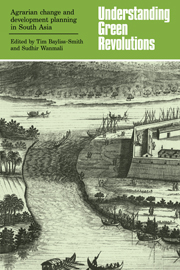Book contents
- Frontmatter
- Contents
- List of contributors
- Preface
- I Understanding Green Revolutions: an overview
- 1 The agricultural revolution in Western Europe
- 2 Land reform as a pre-condition for Green Revolution in Latin America
- 3 Frogs and farmers: the Green Revolution in India, and its murky past
- 4 Agrarian change and the Merchant State in Tamil Nadu
- II Agrarian change at village level
- III Development planning and agrarian change
- Index
3 - Frogs and farmers: the Green Revolution in India, and its murky past
Published online by Cambridge University Press: 25 May 2010
- Frontmatter
- Contents
- List of contributors
- Preface
- I Understanding Green Revolutions: an overview
- 1 The agricultural revolution in Western Europe
- 2 Land reform as a pre-condition for Green Revolution in Latin America
- 3 Frogs and farmers: the Green Revolution in India, and its murky past
- 4 Agrarian change and the Merchant State in Tamil Nadu
- II Agrarian change at village level
- III Development planning and agrarian change
- Index
Summary
The Green Revolution seems to have suffered from one of those optical illusions bound up with the business of ageing. Things which seemed enormous when seen through the eyes of the child look much more modest when viewed again after a passage of years. Green Revolution watching has been around long enough to have developed a fair bit of middle-aged spread. The shining skyscraper seen in childhood now looks like a fairly ordinary apartment block.
In the early years of the Green Revolution, the major criticisms and the major sources of controversy revolved around the effects on distribution. Few doubted the potency of the new technology, but many believed that it would be solely or largely available to a richer minority of the rural population and that as such it would tend to accentuate class divisions in a society which was already badly divided. More recently this topic has been joined and perhaps overshadowed by two other critical commentaries. The first is the observation that the Green Revolution has really caught on in only a few regions and production regimes. In India it has succeeded with wheat, but results have been more equivocal in the case of rice. It has become established in the areas selected for the intensive programme (and of course these areas were selected on the grounds that they were likely to deliver success), but it has not developed a lot of momentum outside these areas (e.g. Dasgupta, 1977). The second is the contention that the Green Revolution never happened.
- Type
- Chapter
- Information
- Understanding Green RevolutionsAgrarian Change and Development Planning in South Asia, pp. 37 - 52Publisher: Cambridge University PressPrint publication year: 1984
- 7
- Cited by



